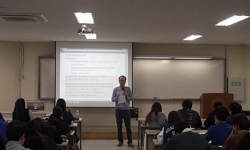아시아 경제는 빠르게 성장하고 있으며, 세계 경제와 국제 무역에 상당한 영향을 미치고 있다. 아시아 각국은 운송망을 더 잘 연결하고 국제화물의 운송을 촉진하기 위해 운송 인프라에 대...
http://chineseinput.net/에서 pinyin(병음)방식으로 중국어를 변환할 수 있습니다.
변환된 중국어를 복사하여 사용하시면 됩니다.
- 中文 을 입력하시려면 zhongwen을 입력하시고 space를누르시면됩니다.
- 北京 을 입력하시려면 beijing을 입력하시고 space를 누르시면 됩니다.
미래 모빌리티 국제기구 연구협력사업 (1)_ KOTI-ITF-EASTS 동아시아 교통연결성국제 공동연구
한글로보기https://www.riss.kr/link?id=E1637314
- 저자
- 발행기관
-
발행연도
2020년
-
작성언어
English
- 주제어
-
KDC
300
-
자료형태
국가정책연구포털(NKIS)
-
0
상세조회 -
0
다운로드
부가정보
국문 초록 (Abstract)
이러한 높은 기대는 COVID-19 이후의 회복을 촉진하고 유라시아에서 국제 무역을 발전시키며 동아시아의 평화와 경제 발전을 촉진할 수 있는 이러한 새로운 연결의 가능성을 포함한다. 교통 기반 시설 투자에 관한 정책 의사결정 과정을 지원하는데 필수적인 교통 네트워크 연결 개선의 영향을 정량적으로 측정할 필요가 있다.
한국교통연구원(KOTI)은 동북아시아, 특히 한반도에서의 운송 연결성에 대한 공통된 이해를 형성하기 위해 국제운송 포럼(ITF) 및 동아시아 운송학회(EASTS)와 공동 연구를 실시했다. ITF는 화물 수요 모델을 기반으로 운송 연결성이 지역 경제에 미치는 예상 영향을 분석하였다. EASTS는 서로 다른 모드의 연결을 분석하고 동북아시아의 도시들에 대한 사례 연구를 제공하였다. 연구 결과는 이 보고서에 결합되어 있다. 이 보고서는 향후 국제교통망 연결 투자 방향과 동북아 연결성 강화 정책 수립에 활용될 수 있기를 기대한다.
아시아 경제는 빠르게 성장하고 있으며, 세계 경제와 국제 무역에 상당한 영향을 미치고 있다. 아시아 각국은 운송망을 더 잘 연결하고 국제화물의 운송을 촉진하기 위해 운송 인프라에 대한 대규모 투자를 통해 지역 경제 통합을 목표로 하는 정책을 시행해 왔다. 최근 동아시아 육상 운송에 큰 걸림돌로 남아 있는 한반도의 육상 운송 네트워크를 연결할 것이라는 기대가 높아지고 있다.
이러한 높은 기대는 COVID-19 이후의 회복을 촉진하고 유라시아에서 국제 무역을 발전시키며 동아시아의 평화와 경제 발전을 촉진할 수 있는 이러한 새로운 연결의 가능성을 포함한다. 교통 기반 시설 투자에 관한 정책 의사결정 과정을 지원하는데 필수적인 교통 네트워크 연결 개선의 영향을 정량적으로 측정할 필요가 있다.
한국교통연구원(KOTI)은 동북아시아, 특히 한반도에서의 운송 연결성에 대한 공통된 이해를 형성하기 위해 국제운송 포럼(ITF) 및 동아시아 운송학회(EASTS)와 공동 연구를 실시했다. ITF는 화물 수요 모델을 기반으로 운송 연결성이 지역 경제에 미치는 예상 영향을 분석하였다. EASTS는 서로 다른 모드의 연결을 분석하고 동북아시아의 도시들에 대한 사례 연구를 제공하였다. 연구 결과는 이 보고서에 결합되어 있다. 이 보고서는 향후 국제교통망 연결 투자 방향과 동북아 연결성 강화 정책 수립에 활용될 수 있기를 기대한다.
다국어 초록 (Multilingual Abstract)
These high expectations include the potential for these new connections to catalyze post-COVID-19 recovery, develop international trade in Eurasia, and promote peace and economic development in East Asia. It is necessary to quantitatively measure the impacts of improved transport network connections, which is essential in supporting the policy decision-making process regarding transport infrastructure investments.
The Korea Transport Institute (KOTI) conducted joint research with the International Transport Forum (ITF) and Eastern Asia Society of Transport Studies (EASTS) to form a common understanding of transport connectivity in Northeast Asia, especially on the Korean Peninsula. ITF analyzed the expected impact of improved transport connectivity on the regional economy based on a freight demand model. EASTS analyzed the connectivity of different modes and provided case studies of cities in Northeast Asia. The results of the research are combined in this report. It is hoped that this report can be used to set the future direction for investment in international transport network connections and policies for enhancing connectivity in Northeast Asia.
The economy of Asia has been growing rapidly, resulting in considerable influence on the global economy and international trade. Countries in Asia have been implementing policies that aim for regional economic integration through large-scale investmen...
The economy of Asia has been growing rapidly, resulting in considerable influence on the global economy and international trade. Countries in Asia have been implementing policies that aim for regional economic integration through large-scale investments in transport infrastructure to better connect the transport network and stimulate transport of international freight. Recently, there have been high expectations for connecting the land transport network on the Korean Peninsula, which remains as a major impediment to East Asian land transport.
These high expectations include the potential for these new connections to catalyze post-COVID-19 recovery, develop international trade in Eurasia, and promote peace and economic development in East Asia. It is necessary to quantitatively measure the impacts of improved transport network connections, which is essential in supporting the policy decision-making process regarding transport infrastructure investments.
The Korea Transport Institute (KOTI) conducted joint research with the International Transport Forum (ITF) and Eastern Asia Society of Transport Studies (EASTS) to form a common understanding of transport connectivity in Northeast Asia, especially on the Korean Peninsula. ITF analyzed the expected impact of improved transport connectivity on the regional economy based on a freight demand model. EASTS analyzed the connectivity of different modes and provided case studies of cities in Northeast Asia. The results of the research are combined in this report. It is hoped that this report can be used to set the future direction for investment in international transport network connections and policies for enhancing connectivity in Northeast Asia.
목차 (Table of Contents)
- Part 1 Introduction and Overview 1
- Introduction 7
- Analysis of Current State and Future Plan for Transport Infrastructure in Northeast Asia 12
- Eurasia Transport Network Connectivity: Plans and Regional Network Analysis 49
- References 67
- Part 1 Introduction and Overview 1
- Introduction 7
- Analysis of Current State and Future Plan for Transport Infrastructure in Northeast Asia 12
- Eurasia Transport Network Connectivity: Plans and Regional Network Analysis 49
- References 67
- Part 2 Impact Analysis of Improving Transport Connectivity in the Northeast Asia Region 73
- Introduction 78
- Review: Korean Peninsula Trade and Transport Connectivity 82
- Review: Existing Overland Trade Routes in Asia and Russia 85
- Scenario Building and Modelling 88
- Scenario Analysis Results: Border Normalization 97
- Conclusion 111
- References 114
- Part 3 Transport Connectivity-Theory and Implementation 116
- Introduction 122
- Analysis of Socioeconomic Impact of Connecting Transport Network in Northeast Asia 126
- Analysis of Public Transport Connectivity 145
- Analysis of Rail Transport Network Connectivity 161
- References 185











